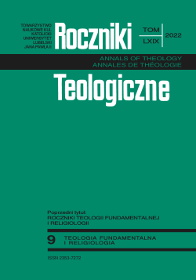Fullness of Life in Mae Enga Traditional Religion and Christ the Life
Abstract
The Mae Enga are friendly, hospitable, strong of character and different from the other groups of Papua New Guinea. Through a brief reflection on the traditional world-view centered life and on evaluation of their concept of life, the study forms a foundation for dialogue and inculturation.
The material used in this article, beside the literature, is data collected during my research in 2020, via one-on-one interview (30 women and 30 men) and group discussions (10 women and 10 men) from two villages: Par and Yampu). A qualitative method was employed.
The findings of the research show that the whole life of the Mae Enga is oriented towards reciprocal relationships with the entire universe to experience abundant life here on earth, within one’s own clan community. Despite the socio-cultural changes that influence their values, beliefs and attitudes, the “life” remains the central value but the ways of obtaining life have changed. The traditional religion is giving space to Jesus Christ the Life, who takes Mae Engans “beyond” their own clan and offers to them a new identity as followers of Christ, Ktaisanya Tata (Tribe of Jesus Christ).
The presented reflection creates a space for dialogue between Christianity and culture. Jesus Christ enters the present Mae Enga socio-cultural reality in order to transform it, to offer a new identity and a new dimension in their search. In turn, the Mae Enga offer to the world the “Face of Christ” with its own cultural features and values, with its ways of worship and reconciliation.
References
Brennan, Paul. Let Sleeping Snakes Lie. Special Studies in Religion. Adelaide: Australian Association for the Study of Religions, 1977.
Dlugosz, Miriam. Mae Enga Myths and Christ’s Message. Fullness of Life in Mae Enga Mythology and Christ the Life (Jn 10:10). Nettetal: Steyler Verlag, 1998.
Dlugosz, Miriam. “Ministering in Oral Cultures Today.” Australian Association for Mission Studies 14, no. 2 (2020): 48–52.
Dlugosz, Miriam. “Changing Perception on the Role of Enga Woman in the Society Today in Kompiam-Ambum District, Enga.” Catalyst 50, no. 1 (2020): 39–63.
Dlugosz, Miriam. “Christ as Kamongo Saka Katao Katenge—The Lord of Life, in the Context of Enga Culture.” In Becoming Intercultural. Perspectives on Mission, edited by Stanislaus T. Lazarus and Christian Tauchner, 327–46. Delhi: ISPCK/Steyler Missionswissenschaftliches Institut, 2021.
Gesch, Patrick. Initiative and Initiation. A Cargo Cult-Type Movement in the Sepik against its Background in Traditional Village Religion. Studia Instituti Anthropos 33. St. Augustin: Anthropos Institut, 1985.
Gibbs, Phil. “The Gospel of Christ in Enga.” In Gospel transformations. SVD’s Reflect on Gospel Preaching in Papua New Guinea, edited by Patrick Gesch, 33–41. Madang: Divine Word Institute, 1994.
Gibbs, Phil. “Titi Pingi, Theology of an Enga Praise Poem.” Catalyst 20/2 (1990): 117–136.
Gibbs, Phil. “Beyond the Fence: Confronting Witchcraft Accusations in the Papua New Guinea Highlands”. International Bulletin of Missionary Research 39/1 (2015): 8–11.
Gibbs, Phil. “I could be the last man: Changing masculinities in Enga society”. The Asia Pacific Journal of Anthropology 17, nos. 3–4 (2016): 324–41. https://doi.org/ 10.1080/14442213. 2016.1179783.
Jentsch, Thunar, and Rainer Doetsch. Keman eine Siedlung im Hochland von Papua Neuguinea. Berlin: Dietrich Reimer, 1986.
Kambao, Lawrence. “The discovery of Weapo Yahweh in Enga Laiapu”. Catalyst 19, no. 4 (1998): 385–98.
Krol, Anthony. Pumakos Parish till 1982. Alexishafen: Stella Press, 1991.
Kyakas, Alome, and Polly Wiessner. From Inside the Women’s House. Enga Women’s Lives and Traditions. Buranda, Qld: Robert Brown and Associates, 1991.
Lacey, Rodrick. “The Introduction of Cash Cropping to the Western Highlands: Some Evidence from Enga.” In Melanesia beyond Diversity, edited by R. J. May and Hank Nelson, 351–71. Canberra: Research School of Pacific Studies, Australian National University, 1982.
Lacey, Rodrick. “The Enga Worldview”. Catalyst 3 (1973): 37–47.
Lacey, Rodrick. “Heroes, 3: Themes in Precolonial Religious Life in Papua New Guinea”. In Powers, Plumes and Piglets: Phenomena of Melanesian Religion, 194–209. Australian Association for the Study of Religions, 1979.
Mantovani, Ennio. Traditional and Present Day Melanesian Values and Ethics. Occasional Papers of the Melanesian Institute 7. Goroka: Melanesian Institute for Pastoral and Socio-Economic Service, 1993.
Narokobi, Bernard. “What is Religious Experience for a Melanesian?” in Christ in Melanesia: Exploring Theological Issues, ed. James Knight, 7–12. Goroka: Melanesian Institute foe Pastoral and Socio-Economic Service, 1977.
Otto, Rudolf. The Idea of the Holy. Translated by J. Harvey. London: Oxford University Press, 1958.
Pernia, Anthony. “The theological significance of multiculturality.” Missio Ad Gentes 2, no. 2. (2016): 2–18.
Pokawin, Stephen. “Cargo cults and development,” Point 1 (1979): 83–95.
Rusoto, Moses R. “Traditional, Western Mae Enga Religion.” Oral History 8, no. 7 (1980): 1–45.
Schroeder, Roger. Initiation and Religion. A Case Study from the Wosera of Papua New Guinea. Fribourg: University Press, 1992.
Wagner, Herdwig, and Herman Reiner, eds. The Lutheran Church in Papua New Guinea. The First Hundred Years (1886–1986). Adelaide: Lutheran Publishing House, 1987.
Wagner, Herdwig. “The Enga Concept of Fear”. In Studies in Missionary Anthropology, edited by Paul Brennan, 245–318. Wapenamanda, 1970.
Copyright (c) 2022 Roczniki Teologiczne

This work is licensed under a Creative Commons Attribution-NonCommercial-NoDerivatives 4.0 International License.





